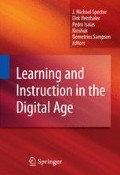Abstract
The aim of this study is to develop a method of qualitative analysis for extracting features/characteristics from e-learning contents, in consideration of the semantic relationship between figures and sentences. In order to extract the features/characteristics, we propose a method of contents analysis for “characteristics on frames” and “sequences of frames.” On the basis of this analysis, we propose a method for contents construction. In comparison with previous research on the subject, our research is aimed to the synergy effect in the meaningful relationship among figures, sentences, and sound narrations; we take a qualitative analysis approach from the point of view of cognitive and linguistic semantics. As a result of that, we extracted three patterns: “Progressive pattern,” “Regressive pattern,” and “Spiral pattern” from the characteristics on analyzed frames. Also, we extracted two patterns for chunked frame sequences: “liner/branch/binding” and “Liner/nonbinding.” Moreover, we try to test “synergy effect” for the compounded contents among figures, sentences, and sound narrations. Also, we propose the concept of “Dance of understanding” from the point of the semantic relationship among those media. We define that “Dance of understanding” is internal behavior to make harmony in brain for understanding a series of learning/instructional materials, accompanied with the several represented media. We assume the degree of this harmony “synergy effect.”
Access this chapter
Tax calculation will be finalised at checkout
Purchases are for personal use only
References
Bruner, R. (1967). Studies in cognitive growth. New York: John Wiley.
Briggs, L. J. (1977). Instructional design: principles and applications. Englewood Cliffs, NJ: Educational Technology Publications.
Carrell, P. L. (1992). Awareness of text structure: effect on recall. Language Learning, 42, 1–20.
Collins, B. (1999). Design, development and implementation of a WWW-based course-support system. Proceedings of the 7th conference of advanced learning technologies, 94–95.
Dick, W., Carey, L., and Carey, J. (2001). The systematic design of instruction (5th ed.). Upper Saddle River, NJ: Addison-Wesley.
Diehl, V., & Mills, C. (1995). The effect of interaction with the device described by procedural text onrecall, true/false, and task performance. Memory & Cognition, 23, 675–688.
Eveland, W. P., & Dunwoody, S. (2001). User control and structural isomorphism or disorientation and cognitive load?. Communication Research, 28(1), 48.
Gagne, R., Wager, W., Goals, K., & Keller, J. (2005). Principles of instructional design (5th ed.). Belmont, CA: Thomson.
Keiko, I. (2000). Comprehension of expository text, a line graph helps readers to build a SituationModel. Japanese Journal of Educational Psychology, 48, 333–342.
Levin, J. R., Anglin, G. J., & Carney, R. N. (1987). On empirically validating functions of pictures in prose (51–86). New York: Springer-Verlag.
Mayer, R. E. (2001). Multimedia learning. New York: Cambridge University Press.
Merrill, M. D. (1983). Component display theory. In C. Reigeluth (Ed), Instructional design theories and models. Hillsdale, NJ: Lawrence Erlbaum Associates.
Nagata, N., & Okamoto T. (2008). The qualitative study on contents analysis/construction method for e-Learning Focusing on the semantic relationship between figure & sentences-. Proceedings of the IADIS (International association for development of the information society) international conference on CELDA (Cognition and Exploratory Learning in Digital Age), 137–144.
Nagata N., & Anma, F., Okamoto, T. (2008). The knowledge circulated – organizational system for e-Learning management -Focusing on Know-How of contents-construction methods-. Proceedings of the AACE (Association for the Advancement of Computing in Education) international conference on e-Learn 2008, pp. 1117–1127.
Nieminen, P. (2001). Videolecturing for international students. Proceedings of International PEG Conference.
Nonaka, I. (1995). The knowledge-creating company. Oxford, England: Oxford University Press.
Okamoto, T. (2000). A distance ecological model to support self/collaborative-learning via internet. Proceedings of the international conference of computer on education, pp. 795–799.
Okamoto, T., Cristea, A. I., and Kayama, M. (2000). Towards intelligent media-oriented distance learning and education environments. In Proceedings of the international conference of computer on education, pp. 61–71.
Robinson, D. H., and Kiewra, K. A. (1995). Visual argument: graphic organizers are superior to outlines in improving learning from text. Jornal of Educational Psychology, 87, 455–467.
Susan, M. M. (1964). Good frames and bad. New York: McKay.
Skinner, B. F. (1958). Teaching machines. Science, 128, 969–977.
William, W. L., & Owens, D. L. (2003). Instructional design. Japan: e-Learning Consortium.
Author information
Authors and Affiliations
Corresponding author
Editor information
Editors and Affiliations
Rights and permissions
Copyright information
© 2010 Springer Science+Business Media, LLC
About this chapter
Cite this chapter
Nagata, N., Okamoto, T. (2010). The Qualitative Study on Contents Analysis/Construction Method for e-Learning. In: Spector, J., Ifenthaler, D., Isaias, P., Kinshuk, Sampson, D. (eds) Learning and Instruction in the Digital Age. Springer, Boston, MA. https://doi.org/10.1007/978-1-4419-1551-1_8
Download citation
DOI: https://doi.org/10.1007/978-1-4419-1551-1_8
Published:
Publisher Name: Springer, Boston, MA
Print ISBN: 978-1-4419-1550-4
Online ISBN: 978-1-4419-1551-1
eBook Packages: Humanities, Social Sciences and LawEducation (R0)

